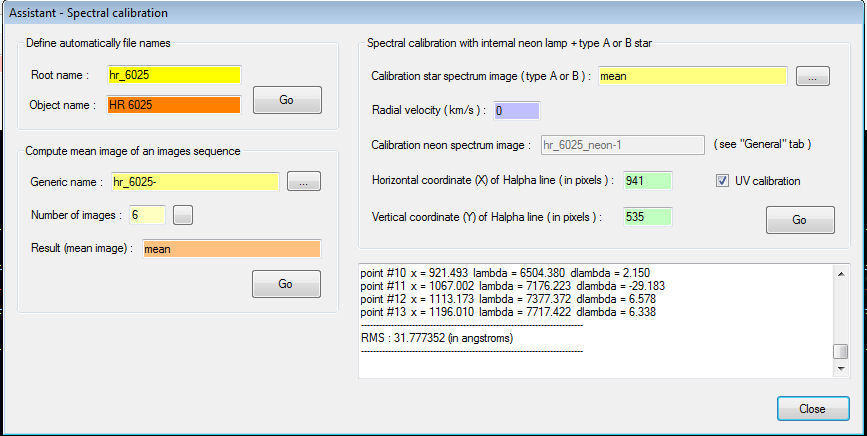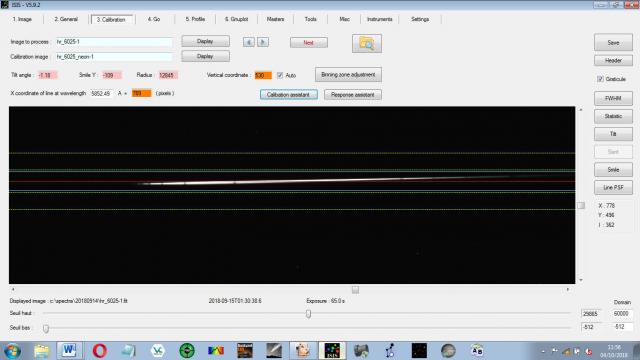› Forums › Spectroscopy › Unable to calibrate a spectrum in ISIS
- This topic has 18 replies, 2 voices, and was last updated 7 years, 2 months ago by
 Robin Leadbeater.
Robin Leadbeater.
-
AuthorPosts
-
4 October 2018 at 12:49 pm #574137
 John CoffinParticipant
John CoffinParticipantI would be grateful for any help. I have previously successfully used ISIS with a DSLR and an Alpy 600. I’ve started using an Atik 460 binned x 2 with my Alpy. I calculated the pixel scale using the formula 3123/(difference in pixels between H alpha and H beta). In my case the pixel scale works out to 8.747. I checked the distance between H alpha and beta on both my calibration star, HR 6025 (A0Vn) and the target AG Draconis.
I believe I have set everything up properly for ISIS but the calibration assistant fails to provide an adequate calibration. The RMS is 31.7.
I’ve uploaded lots of screen shots below.
Here are the numbers generated by the wizard.
Lines search zone
| -8 | 375 | 0 |
| -2 | 381 | 6 |
| -4 | 400 | 4 |
| 0 | 423 | 8 |
| 0 | 473 | 8 |
| -8 | 588 | 0 |
| -2 | 786 | 10 |
| -2 | 805 | 10 |
| 0 | 871 | 12 |
| 0 | 923 | 12 |
| -4 | 1067 | 8 |
| 0 | 1114 | 14 |
| -5 | 1196 | 9 |
Gaussian fit on : +/-5 pixels
————————————————————————–
Reciprocical inverse dispersion equation
Coefficient a4 : -8.933238E-10
Coefficient a3 : 1.693153E-06
Coefficient a2 : -8.668276E-04
Coefficient a1 : 4.84377
Coefficient a0 : 2091.448
————————————————————————–
Fitting deviation (wavelength)
point #1 x = 375.443 lambda = 3864.395 dlambda = -29.005
point #2 x = 380.701 lambda = 3889.225 dlambda = -0.175
point #3 x = 399.765 lambda = 3979.381 dlambda = -9.301
point #4 x = 418.000 lambda = 4065.822 dlambda = 35.928
point #5 x = 468.000 lambda = 4303.956 dlambda = 36.524
point #6 x = 594.604 lambda = 4914.239 dlambda = -52.899
point #7 x = 786.384 lambda = 5851.107 dlambda = 1.383
point #8 x = 804.791 lambda = 5940.925 dlambda = 3.905
point #9 x = 866.129 lambda = 6238.731 dlambda = 27.759
point #10 x = 921.493 lambda = 6504.380 dlambda = 2.150
point #11 x = 1067.002 lambda = 7176.223 dlambda = -29.183
point #12 x = 1113.173 lambda = 7377.372 dlambda = 6.578
point #13 x = 1196.010 lambda = 7717.422 dlambda = 6.338
————————————————————————–
RMS : 31.777352 (in angstroms)
4 October 2018 at 2:37 pm #580043 Robin LeadbeaterParticipant
Robin LeadbeaterParticipantHi John,
Does it work ok with just the calibration lamp? ie without the wizard,ticking “predefined mode” “ALPY (calibration module)” in “general” and entering the position of the 5852 line in “calibration”
Robin
4 October 2018 at 4:57 pm #580045 John CoffinParticipant
John CoffinParticipantThanks for your suggestion. The best calibration I can get with the method you suggested gives an RMS of 19.976 Angstroms. I hope I am using the correct neon line (marked below with an arrow). I have even updated the version of ISIS to the latest one. I have also tried adjusting the pixel scale by increments of 0.02, but no luck.
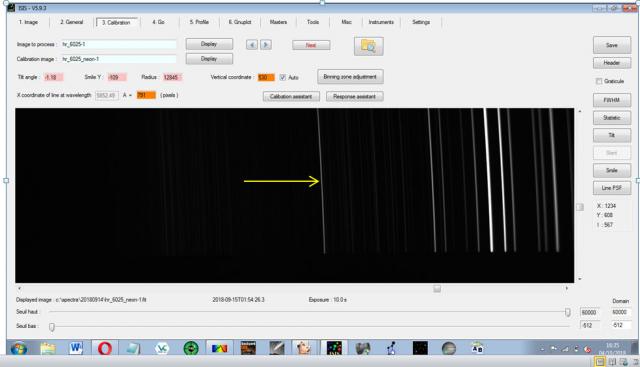 4 October 2018 at 5:17 pm #580046
4 October 2018 at 5:17 pm #580046 John CoffinParticipant
John CoffinParticipanti calibrated the same star in RSpec using a third order polynomial and with an RMS of 0.6539, just by using the Balmer lines. I’d really rather be able to use ISIS as it is so much more powerful and does all the stacking etc.
4 October 2018 at 5:42 pm #580047 Robin LeadbeaterParticipant
Robin LeadbeaterParticipantHi John
Yes that is the right reference line. ISIS should definitely work with the camera you have and the method I suggested, I use it all the time. (The high errors means ISIS is failing to find and lock onto the correct lines)
Can you check that the smile correction has worked correctly please. Run the calibration on the lamp spectrum itself instead of the target star, ticking sky background not removed. (you will need to put a 1 on the end of the file name so ISIS sees it as the first of a series) If you then examine the image (“display image”) in the page you get after pressing go, the lines should be vertical and straight.
Can you also post the original image as a zip file please and I will see if I can get it to work this end.
Cheers
Robin
4 October 2018 at 6:12 pm #580048 Robin LeadbeaterParticipant
Robin LeadbeaterParticipantIt could also be worth exploring pixels sizes more widely either side. With my setup (an ATK428, smaller but with same size pixels) I get a good lock and calibration (RMS 0.13A) for 2x binned pixel sizes between 8.90 and 9.06 for a nominal 4.54×2 = 9.08. Using the 3123/(difference in pixels between H alpha and H beta) formula, I get 9.02 which is towards the top end of the lock range
(I was going to attach an example lamp image for comparison but max allowed size is 2Mb and zipped files are not allowed. Can you send me your image via email to robin_astro (at) hotmail.com please)
Robin
4 October 2018 at 6:30 pm #580049 Robin LeadbeaterParticipant
Robin LeadbeaterParticipantYou can download my lamp image here
https://drive.google.com/open?id=1I1UiZhmynSmkF19Fq3ce9foTsRF93ZgN
Robin
4 October 2018 at 10:51 pm #580051 John CoffinParticipant
John CoffinParticipantDear Robin, I tried checking that the smile correction is working but unfortunately I couldn’t get a result. I am obviously not doing it properly. I will look at your lamp image.
4 October 2018 at 10:52 pm #580050 John CoffinParticipant
John CoffinParticipantThanks, am emailing you two zip files now. John
4 October 2018 at 11:23 pm #580052 Robin LeadbeaterParticipant
Robin LeadbeaterParticipantThanks for the files. I now see the problem. When ISIS does the geometric correction for smile, this shifts the X positions of the lines so the entered X reference position for the line that ISIS works out the other lines from is not correct and it cannot lock on. This does not give a problem if the lines are close to vertical, for example in my case the shift is only 2 pixels. If there is a significant slant though the shift can be significant (+15 pixels in your case) If you add 15 pixels to the reference position, I think you should find the calibration runs correctly. Can you try it and see what happens? (It ran for me giving an RMS of 0.3A but I have not tried it combined with the Balmer lines using the wizard)
The slant can be corrected in the ALPY by rotating the grism to make the lines perpendicular to the dispersion direction. (It is simple to do. I did this with my ALPY when I received it and I will dig out the instructions) but I am a bit surprised ISIS does not take this shift into account. I will check with Christian Buil via the ARAS forum
Cheers
Robin
5 October 2018 at 12:21 am #580053 Robin LeadbeaterParticipant
Robin LeadbeaterParticipantHi John,
See answer #9 above for the source of the problem. Actually, I see now that the slant of the lamp lines is partly because the dispersion is not exactly horizontal, as seen in the star image. If next time you rotate the camera to make the star spectrum horizontal, the calibration might run ok without needing to change the X position entered or adjust the grism.
Cheers
Robin
5 October 2018 at 2:49 am #580054 John CoffinParticipant
John CoffinParticipantDear Robin, I hope you were up observing and not just working on my problem. I am most grateful for your help and will follow your advice.
Many thanks, John
5 October 2018 at 10:08 am #580055 John CoffinParticipant
John CoffinParticipanti was surprised that ISIS doesn’t recalculate the X position if the spectrum is rotated. I knew the spectrum was not horizontal, it was my first one with the new camera, but assumed that when ISIS measured the tilt it would make the necessary corrections. Thanks again, I am babysitting today but will try your sugestions tomorrow.
5 October 2018 at 11:08 am #580056 Robin LeadbeaterParticipant
Robin LeadbeaterParticipantI agree. I found it by looking at the position of the lines in the geometric corrected spectrum image. (This could be a work round by running the calibration a second time applying the offset seen in the image ) I am awaiting feedback from Christian
Robin
5 October 2018 at 11:42 am #580057 Robin LeadbeaterParticipant
Robin LeadbeaterParticipantAs a further test, the calibration also runs ok with the original X position (though with slightly lower precision and resolution and poor sky background subtraction of course) if you run without the smile correction (by putting a very large value for the radius)
5 October 2018 at 3:58 pm #580058 Robin LeadbeaterParticipant
Robin LeadbeaterParticipantFor any LHIRES /LISA users which might be following this, The error is specific to the smile correction used with the ALPY. I have checked the slant correction that ISIS uses with LHIRES, LISA and this works correctly.
Robin
6 October 2018 at 9:47 am #580059 John CoffinParticipant
John CoffinParticipantDear Robin, your method worked. Thanks a lot. The calibration is shifted to the blue by about 1.5 A, so I guess the lesson to learn here is for me to get my spectrum straight and try again. Here are my first spectra with this set up.
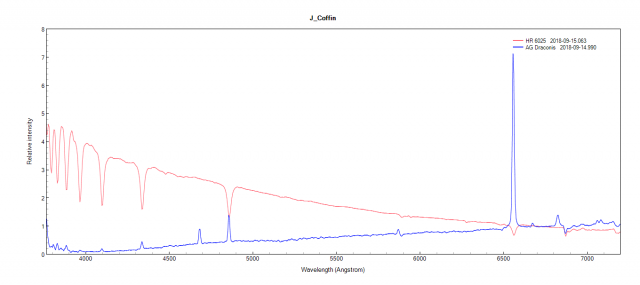 6 October 2018 at 11:22 am #580060
6 October 2018 at 11:22 am #580060 Robin LeadbeaterParticipant
Robin LeadbeaterParticipantThat’s great !. If you still have problems with the spectrum horizontal, you can also adjust the ALPY grism to make the lines exactly vertical. If you look at the core module,you can see the grism held in place by allen head grub screws. If you loosen them off you can rotate the grism, viewing a spectrum by eye until the spectral lines are square to the dispersion direction. (Take care not to loosen to much and hold the grism holder in place as there is a spring behind it)


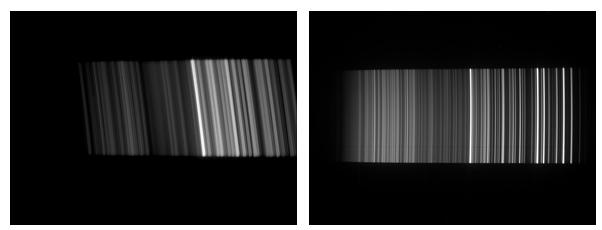 6 October 2018 at 11:40 am #580061
6 October 2018 at 11:40 am #580061 Robin LeadbeaterParticipant
Robin LeadbeaterParticipantIt seems ALPY grisms out of adjustment is a common problem. I thought I remembered commenting on this here before
https://britastro.org/node/14085
Robin
-
AuthorPosts
- You must be logged in to reply to this topic.


